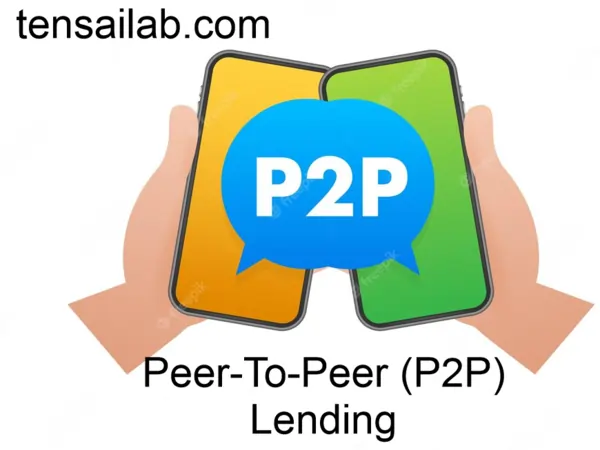

Need a loan but are frustrated with how traditional lending works? Peer-to-peer (P2P) lending is a solution that could change the game and is worth looking into. If you’ve ever had trouble getting a loan because your credit score wasn’t good enough, P2P lending could be the answer you’ve been looking for. In this blog, we’ll talk about how peer-to-peer lending works, so you can decide whether to invest confidently.
Understanding Peer-to-peer Lending
Peer-to-peer lending, also called “social lending,” is a different way to get money without going through banks or other traditional financial institutions. It works through online platforms that put lenders and borrowers in direct contact.
This way of lending money is constructive for people with bad credit who have trouble getting money through other means. But it’s important to remember that borrowers may have to pay more in interest as a trade-off.
On the other hand, lenders who want higher returns than they can get from traditional savings accounts or other investments find P2P lending appealing, despite the higher risk. Peer-to-peer lending is becoming increasingly popular, and many online platforms have sprung up to help people borrow money.
How Does Peer-to-peer Lending Work?
Peer-to-peer lending is done through online platforms that bring together people who want to lend and people who want to borrow money. To take part, users must sign up on the platform. This usually involves giving some basic personal information and paying a small fee.
Compare various platforms to find the one that fits your needs the best.
If you want to borrow money, you must give more information, like your credit history, how much money you make, and whether or not you have a job. Even though credit scores are not the only factor in P2P lending, having a solid credit profile could help you get lower interest rates.
After you upload your information, you will choose how much of a loan you want and agree to the interest rate you might get.
At this point, lenders look at the loan listing and decide whether to fund it.
Once your loan is approved, you, as the borrower, will get the money. It can be paid for by a single lender or a group of lenders.
The P2P platform is used to make sure that payments are made on time. If there is more than one lender, the repayments are split automatically based on how much each lender puts into the loan.
At first, P2P platforms were used mainly by people who had trouble getting loans from traditional sources. But now that more structured platforms make social funding easier, even people with good credit are turning to P2P lending. This is because they can get lower interest rates than banks.
Who Can Lend Using A P2p Platform?
On a P2P platform, A valid PAN Card and a bank account can become a lender. This includes HUFs, partnership firms, and any other made-up person, whether they are incorporated or not.
How Is A P2p Platform Regulated?
Even though P2P platforms have a high level of risk, they are still considered safe. The Master Directions for NBFC Peer-to-Peer Lending Platform, released in 2017, set up the rules for P2P lending. Some critical parts of the rules are:
The RBI must give P2P lenders a Certificate of Registration.
The Division of Non-Banking Regulation in Mumbai requires all NBFCs on the P2P platform to register.
All P2P lenders must keep a maximum leverage ratio of 2, meaning their outstanding loans should not be more than twice the amount of their capital.
All P2P platforms must follow the rules set by the RBI.
Since The Rbi, Borrowers And Lenders Regulate P2p Lending Can Feel Safe About It.
Tax Implications Of Peer-to-peer Lending
According to the Indian Income Tax, only the interest is taxed, not the principal. Section 56(2) of the Income Tax Act of 1961 lists interest income under “Income from other sources.”
This amount of interest is added to the lender’s overall earnings and taxed at the rate for his or her income tax slab.
Section 194A of the Income Tax Act, 1961, says what to do about TDS (Tax Deducted at Source) on interest.
TDS is taken out if the borrower is an individual who is subject to a tax audit and if the interest paid to any lender in a financial year is more.
Peer-to-Peer lending platforms are just middlemen, and it is up to the borrower to follow TDS regulations.
The amount of the loan’s principal cannot be used as a capital gain or loss.
GST is not charged on income from loan interest.
P2P lending platforms charge a processing fee. This fee is subject to GST.
By giving the platform its GST number, lenders can get credit for GST on processing fees and registration fees.
In the 2022 budget, Section 80C from the Income Tax Act or particular provisions to lower tax rates were proposed for P2P lending investments. This was meant to give investors a reason to take part in P2P lending and give people more money to spend.
Pros Of Peer-to-peer Lending
Here Are Several Of The Advantages Of Peer-to-peer Lending:
- Access To Funds
- People Who Have Trouble Getting Loans Through Traditional Means Can Use P2p Lending As An Alternative Way To Get Money.
- Comparable Interest Rates
- Compared To Traditional Lenders, P2p Lending Platforms Often Have Lower Interest Rates, Which Is Good For Borrowers.
- Streamlined The Process
- Using Online Platforms, P2p Lending Makes It Easier For Borrowers And Lenders To Lend And Borrow Money.
- Diversification For The Lenders
- P2p Lending Lets Lenders Spread Their Money Out Among Several Borrowers, Which Could Lower The Risk Of Their Investments.
Cons Of Peer-to-peer Lending
Now That You Know About The Pros, Here Are Some Cons:
- Higher Default Risk
- Because borrowers might not be able to repay their loans, P2P lending has a higher risk of failure than traditional lending.
- Protection From The Law Is Limited.
- P2p Lending Platforms May Not Be As Closely Regulated As Traditional Banks, Meaning Borrowers And Lenders May Have Less Protection.
- Lack Of Honesty
- Some peer-to-peer lending platforms may not be clear about the borrower’s financial history and creditworthiness, making it hard for lenders to accurately assess risk.
- Potential For Fraud
- Fraudulent Activities, Like Fake Borrowers Or Lenders, Can Happen On P2p Lending Platforms, So Users Must Be Careful And Research.
Conclusion
P2P lending has changed how people borrow money by giving all kinds of borrowers an easy way to use crowdfunding. Lenders have found an excellent way to put their money to work that could lead to higher interest rates. Registering on a trustworthy P2P platform regulated by the RBI makes it easier to get money quickly. But it’s essential to be careful and consider the interest rates and additional fees that come with P2P loans. You can get the most out of this popular alternative to a loan if you stay informed and make intelligent choices.

Leave a Reply